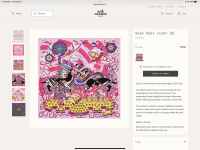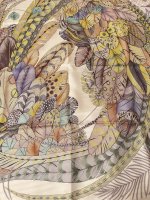What beautiful colors, Cooshcouture. So bright and cheery, elegant, too. If you didn’t receive the laminated item tag, I don’t think that is normal. I would call them.Hi I just received my hermes scarf that I ordered it on Hermes website. To my surprise there us no paper attach to the fabric label. All my other scarves came with it. Is this happened or normal ? TiaView attachment 5276453
You are using an out of date browser. It may not display this or other websites correctly.
You should upgrade or use an alternative browser.
You should upgrade or use an alternative browser.
Scarves Scarf of the Day 2021 - Which Hermès scarf are you wearing today?
- Thread starter bunnycat
- Start date
TPF may earn a commission from merchant affiliate
links, including eBay, Amazon, and others
- Status
- Not open for further replies.
More options
Who Replied?grest sotd! is that a 90 moussie? Amazing colors in it. Love itAnother artist for Saturday - Florence Manlik!
Brides de Gala en Finesse
View attachment 5276474
And a textile art in Tapis Persan - SOTD
View attachment 5276475
My sotd for last day of Christmas shopping. Joies D’hiver.
I wanted to highlight this lovely couple! I think with @Redbirdhermes post on ecosse and all the plaid talk about it after I HAD to highlight him

I wanted to highlight this lovely couple! I think with @Redbirdhermes post on ecosse and all the plaid talk about it after I HAD to highlight him


Brilliant and utterly charming!My sotd for last day of Christmas shopping. Joies D’hiver.
I wanted to highlight this lovely couple! I think with @Redbirdhermes post on ecosse and all the plaid talk about it after I HAD to highlight him
View attachment 5276730
Both of those colors are gorgeous. They came in such good colors. I found the gavroche at the h sale last summer and wish I had a GM, too.@Maedi sisters with AdS. @HoneyLocks, what fascinating horsemanship. The wonderful textile art in Alice Shirley’s beloved design is the Shyrdak hand-made felt wool rug-making of the Kazakhs and Kyrgyz people. Your AdS varieties are fabulous, Maedi. Here are my two, both 90s but I wouldn’t kick if I found a gav. What a beautiful design!
View attachment 5276664View attachment 5276665
Love, love, love the fellow skating in the red kilt. I had never noticed him before so took a look at my scarf. He is wearing yellow. Gotta say, I prefer that red outfit by far.My sotd for last day of Christmas shopping. Joies D’hiver.
I wanted to highlight this lovely couple! I think with @Redbirdhermes post on ecosse and all the plaid talk about it after I HAD to highlight him
View attachment 5276730
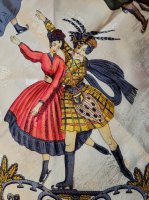
Of course! “Brides de Gala en finesse” in ..just glorious..le sigh. I have the regular twill version. Trade ya...no? Ok.Another artist for Saturday - Florence Manlik!
Brides de Gala en Finesse
View attachment 5276474
And a textile art in Tapis Persan - SOTD
View attachment 5276475
@Maedi sisters with AdS. @HoneyLocks, what fascinating horsemanship. The wonderful textile art in Alice Shirley’s beloved design is the Shyrdak hand-made felt wool rug-making of the Kazakhs and Kyrgyz people. Your AdS varieties are fabulous, Maedi. Here are my two, both 90s but I wouldn’t kick if I found a gav. What a beautiful design!
View attachment 5276664View attachment 5276665
I love the strong graphics on this! Another “ coulda woulda shoulda”
It looks great with the turquoise !
I love his work.. so dynamic, energetic and expressive! Beautiful exampleAnother artist today with Hubert De Watrigant, Croquis Champs de Courses.
View attachment 5275721View attachment 5275722
Thanks so much! Yes, this is my sole CW of Pierres, though I’ve always wanted at least one more… perhaps one of the more colorful CWsSuch wonderful knowledge in the details thank you! And WOW this look is amazing With the neck Warmer! Amazing.
so sorry for your loss. But so nice to be able to share his love of stamps. An amazing acquisition.
Lovely tie with plaines. I always see this scarf get scooped up often in purchases but don’t think I have seen it tied. It looks so great! And is there any scarf that doesn’t look amazing in a black border. I also like this colorway of Pierres. So different. is this the only colorway you own of it?
ooooooo such beautiful soft coziness in green! And the artistry of those drawings. Art is amazing
Love this design so much! Not only a charming illustration but such a lovely Christmas jacquard! A holiday favorite for sureSOTD to do some holiday celebrating. Joies d’Hiver.
View attachment 5275741
Oh, what a great post and lovely tribute to your dear mom, who was a leader and inspiration… Impossible to choose a CW as both are amazingRed you inspired me to share a little of my origin story. My mom was a public servant in Trinidad. Working first for the Ministry of Health, then the Ministry of Education until she retired. For those unfamiliar, a public servant is another name for a government employee and those ministries are the British equivalent of your American departments of health or education. Trinidad was a British colony up until 1962 so most of our pillars are British modeled - system of government, education, law, main religion (Catholicism), language, and our spelling (lol) etc. Back in the day and in my childhood they all wore uniforms and I remember her mixing and matching the suit jackets and pants with multiple solid or patterned blouses or inner shells. I loved seeing the outcome and the effect of her adding a brooch or necklace for some pizazz. She started pretty young in the service as a clerk typist and stenographer - elevating to the highest grade level possible and running her own department years later. I always remember seeing those pitman shorthand books around the house and being totally unable to make sense of the hieroglyphics. I had Les Sportives on my list forever and two came up on TRR in two days and of course I ordered both being unable to choose a colorway. Shoutout to @Snausages for pinging me about it! I can’t decide which to return and the window is closing soon! I’ve included two pics of my mama in her uniforms and I raise a glass to her this night. **cheers**
Such a lovely thing to say… I so appreciate it!Your posts are so informative! I feel like I am taking a survey course in art history and anthropology. I have never paid attention to L’Art Indien des Plaines ..it always read as modern and yet, here it is with the tribal bead art. H artists are just so clever. Thank you for always helping me appreciate these silks at another level!
Love this dip dye hueSOTD and art in itself. First edition dd Brides de Gala. There was a most charming reindeer ad with these dip dyes.View attachment 5276077View attachment 5276087
A magnificent design… Love this wonderful CWThe South African protea flower is represented in silk, ceramics, and other artistic expressions.View attachment 5276095
A beautiful classic… I own the red, but this rich blue is lovelyOh @Karenska: are we twins? Here is my Joies d’Hiver…View attachment 5276228
Adore this CW… So wearable!OOTD a wonderful redcoloured Mountain Zebra.
Have a great weekend! View attachment 5276231
Wonderful CW of this beautiful classic
Both are such wonderful silks, and each so different… Must admit that Zabavushka is masterful and one I love to wear at this time of year as well… So glad you posted it! We have some things in common, one being that we are both Art Historians!Good morning! I just adored this week's theme. I was an Art History double major in college so I was in throwback heaven! Thank you all for the incredible loveliness and thoughtful connections. I am closing out with two: My beloved Zabavushka, which was actually based on the Toy Museum and as @SusieAugusta pointed out Museums have art! This is folk art and the museum was created to preserve the craft of traditional toys made of straw and clay and textiles. It is a hands on museum where children can actually touch the pieces and take classes. You can find some fun information online-- I thought the museum's logo looked a lot like one of Evgenia Miroschnichenko's toys!
View attachment 5276299
I wore it last week to a holiday event with a holiday sweater:
View attachment 5276300
And today I am wearing a sister scarf to @Living.la.vida.fifi's: Selle des Steppes tied to show as much holiday color as possible, including a gold star and some glitter ball earrings!
View attachment 5276303
So great on you! I hardly wear this one but have been inspired by you and moma to do so more oftenMy scarf of the day is Dame du Coeur a Vous L’Honneur. Both @Living.la.vida.fifi and @momasaurus own this scarf. I'm wearing it today, because as moma has said, it goes so beautifully with many outfits. Thank you, Fifi, for highlighting this scarf earlier in the week.
View attachment 5276318
Both are wonderful… I’ve always thought that BdG Finesse shines as a moussieAnother artist for Saturday - Florence Manlik!
Brides de Gala en Finesse
View attachment 5276474
And a textile art in Tapis Persan - SOTD
View attachment 5276475
It is a fabulous design in the style of traditional textiles of KyrgyztanFabric art on Appaloosa des Steppes. Someone on tPF posted some fabric pictures a while back which made me love the design even more. Gavroche and 90 cm.View attachment 5276604View attachment 5276605View attachment 5276606View attachment 5276607
A design that deserves multiples, IMO… You are so lucky to own two CWs! I am happy to be your twin on the first CW@Maedi sisters with AdS. @HoneyLocks, what fascinating horsemanship. The wonderful textile art in Alice Shirley’s beloved design is the Shyrdak hand-made felt wool rug-making of the Kazakhs and Kyrgyz people. Your AdS varieties are fabulous, Maedi. Here are my two, both 90s but I wouldn’t kick if I found a gav. What a beautiful design!
View attachment 5276664View attachment 5276665
Amazing knot highlighting that delightful skating coupleMy sotd for last day of Christmas shopping. Joies D’hiver.
I wanted to highlight this lovely couple! I think with @Redbirdhermes post on ecosse and all the plaid talk about it after I HAD to highlight him
View attachment 5276730
A magnificent silk!Plums en fete
Wrapping up the week with a few more silks, beginning with Cent Plis des Miao, designed by Aline Honoré. This marvel of an illustration pictures a pleated skirt, the traditional costume of the Miao Minority people of China, viewed from above as it lays on stylized and geometric patterned textiles characteristic to this cultural group. Dancing ribbons and a silver horse amulet complete the still life. The Hermès catalog states, “This carre prompted a meeting with the Museum of Quai Branly in Paris. Offered by Hermes, the skirt now figures amongst its collections.“
Following pics of my 90 and CSGM, some photographs of Chinese Miao women wearing the traditional multi pleated skirts, a Miao pleated skirt and a silver horse amulet of the Miao people that resembles the one on the scarf.

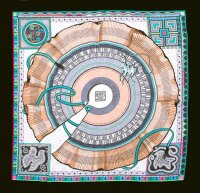
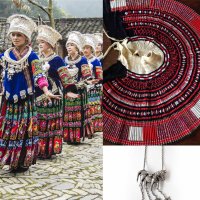
Next is Animaux Solaires by Zoe Pauwels. The theme of this scarf is literally based on Tibetan mandalas from the 15th-16th centuries that represent a heliocentric universe where creation revolves around the solar force. A lion, horse, stag and eagle chase each other infinitely on a field with the sun at its core. Mandala is a Sanskrit word meaning “circle,” and, at the most basic level of appearance, that’s what a mandala is, a beautifully inscribed circle adorned with geometric patterns and digital forms. Before learning that its design was based on Tibetan mandalas, I thought it was inspired on medieval Insular illustrations such as those found in Gospel books like the legendary Book of Kells. I definitely see stylistic similarities between medieval illuminated manuscripts and sacred Tibetan mandalas in common characteristics such as the usage of geometric patterns, organic forms and highly dense, intricate decorative patterns.
After the scarf, a collage showing a Tibetan mandala and some examples of illuminated pages from the Irish Book of Kells and Lindisfarne Gospels
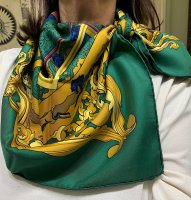
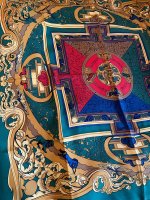
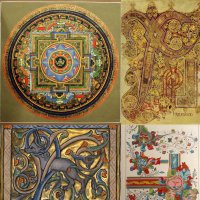
Zoe Pauwels designed Aube Libre Comme l’Ange as a tribute to the Japanese band l’Alfee and its 1977 music project by the same name. The design is in the style of graffiti art. Below, pics of the scarf followed by graffiti examples.
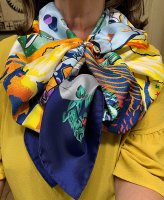
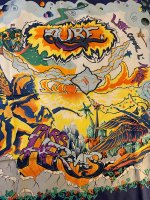

Rayures Mexicaines, or Mexican Stripes was only issued in mousseline form and consists of a series of multicolored stripes trimmed by a classic belt and buckles pattern. I do not know who designed it and would appreciate any information.
Following pictures of the scarf is an image of a Mexican woven blanket, or serape.
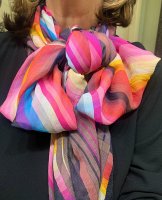
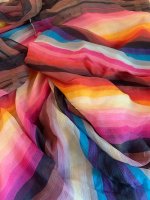
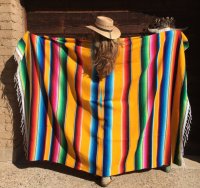
Thank you for allowing me to host this wonderful week on SOTD. It has been a great honor and pleasure to share some of my silks and to learn so much from everyone here
Following pics of my 90 and CSGM, some photographs of Chinese Miao women wearing the traditional multi pleated skirts, a Miao pleated skirt and a silver horse amulet of the Miao people that resembles the one on the scarf.



Next is Animaux Solaires by Zoe Pauwels. The theme of this scarf is literally based on Tibetan mandalas from the 15th-16th centuries that represent a heliocentric universe where creation revolves around the solar force. A lion, horse, stag and eagle chase each other infinitely on a field with the sun at its core. Mandala is a Sanskrit word meaning “circle,” and, at the most basic level of appearance, that’s what a mandala is, a beautifully inscribed circle adorned with geometric patterns and digital forms. Before learning that its design was based on Tibetan mandalas, I thought it was inspired on medieval Insular illustrations such as those found in Gospel books like the legendary Book of Kells. I definitely see stylistic similarities between medieval illuminated manuscripts and sacred Tibetan mandalas in common characteristics such as the usage of geometric patterns, organic forms and highly dense, intricate decorative patterns.
After the scarf, a collage showing a Tibetan mandala and some examples of illuminated pages from the Irish Book of Kells and Lindisfarne Gospels



Zoe Pauwels designed Aube Libre Comme l’Ange as a tribute to the Japanese band l’Alfee and its 1977 music project by the same name. The design is in the style of graffiti art. Below, pics of the scarf followed by graffiti examples.



Rayures Mexicaines, or Mexican Stripes was only issued in mousseline form and consists of a series of multicolored stripes trimmed by a classic belt and buckles pattern. I do not know who designed it and would appreciate any information.
Following pictures of the scarf is an image of a Mexican woven blanket, or serape.



Thank you for allowing me to host this wonderful week on SOTD. It has been a great honor and pleasure to share some of my silks and to learn so much from everyone here
@Fifi, thank you for hosting and your marvelous contributions. You look so energetic and radiant in your photos. Thank you also for the kind words to my posts.
Thank you for your kind words!Oooooh! This is a gorgeous colorway. Wonderful styling
Hi I just received my hermes scarf that I ordered it on Hermes website. To my surprise there us no paper attach to the fabric label. All my other scarves came with it. Is this happened or normal ? TiaView attachment 5276453
[/QUOTE
There is never any paper tag when I buy my scarves from a store, and there is sometimes one when I buy online.
- Status
- Not open for further replies.
Register on TPF! This sidebar then disappears and there are less ads!

